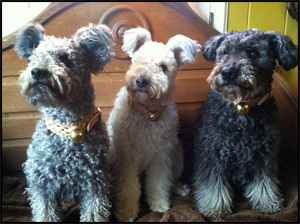
Hungarian Pumi
Origin: Hungary
Height:
– Males: from 16 to 18 1/2 inches
– Females: from 15 to 17 1/2 inches.
Weight:
– Males: ideally 27 to 29 lbs
– Females: 22 to 24 lbs

Fruska, Agyag, and Csupasz
Photo: Catskill Pumi Kennel
CLICK HERE to View Breeder Listings
Breed Profile
The Pumi is considered a medium-sized dog; known to be energetic, alert, intelligent and agile.
A Hungarian herding breed that originated in the 17th or 18th century used to herd cattle, sheep and pigs. The Pumi is a versatile herding dog that uses his voice and quick movement to gather, drive and keep the stock within boundaries.
This is an active breed that combines the intelligence of a herding dog with the alertness of a terrier. Because of this, the Pumi does best when he has a job to do, whether it’s herding or other dog sports, such as flyball, agility or obedience.
The Pumi’s coat is wavy and curly, forming corkscrews or curls all over the body. Pumis do not shed but do require grooming about every 3 months. He is black, white, or any shade of gray. Shades of fawn, from pale cream to red, with some black or gray shading is desirable.
The Pumi carries his head and tail up and has a light, energetic and efficient gait.
The Pumi is a very rare breed in North America with only one to three litters born each year.
Health Issues
The Pumi is known to be a very healthy breed. However, according to the Hungarian Club of America, Hip Dysplasia appears to be the most common problem found in the breed. The Pumi is also known to possibly carry the gene for Degenerative Myelopathy (DM) and there have also been cases of Primary Lens Luxation (PLL)in puppies in Europe.
The Hungarian Club of America recommends that all Pumik have OFA x-rays for Hip Dysplasia as well as DNA testing for DM and OFA DNA testing for PLL.
If you are considering the adoption of a Pumi puppy, or any breed, it is very important to be selective in choosing a responsible and reputable breeder. Ensure that the prospective puppy’s parents have all health clearances. Breeding of any dog should not be done until after they have been proven to be free of evidence of significant hereditary diseases. (For more information on selecting a breeder, see the articles on the main General Information page.)
Additional Health Resources:
- Health and Nutrition — Growing section of the Canada’s Guide to Dogs website which includes information on several health and nutrition related issues.
- Canine Health Information Center (CHIC) — Providing a source of health information for owners, breeders, and scientists that will assist in breeding healthy dogs. CHIC is a centralized canine health database jointly sponsored by the AKC/Canine Health Foundation (AKC/CHF) and the Orthopedic Foundation for Animals (OFA).
- AKC Canine Health Foundation — Working towards developing scientific advances in canine health.
- OFA – Companion Animal Eye Registry (CAER)
- Orthopedic Foundation for Animals (OFA)
- Ontario Veterinary College (OVC)
- University of Pennsylvania Hip Improvement Program (PennHip)
- HealthGene — HealthGene Corporation is the leading provider of veterinary DNA diagnostic services in Canada.
- Labgenvet — Laboratory of Veterinary Genetics is a Canadian diagnostic laboratory that offers a comprehensive service of DNA tests for veterinary genetic diseases.
Grooming Information
- Grooming — This section of the Canada’s Guide to Dogs website includes tips, articles and information covering all aspects of dog grooming along with a listing of Groomers from across Canada.
Training Resources
- Training — For training information, see this growing section of the Canada’s Guide to Dogs website for tips, articles, as well as listings of training centres across Canada.
Additional Information
- Herding Dogs — A section of the Canada’s Guide to Dogs website which includes training and general information about Herding/Stock Dogs; listing of Stock Dog Clubs and Associations; listing of upcoming shows and events; and more.
- Clubs, Sports & Activities — For information on the many sports and activities you can get involved in with your dog.
- Working Dogs — The Working Dogs section of the Canada’s Guide to Dogs website provides information and listings of organizations that are involved in various dog jobs, such as Guide Dogs, Therapy Dogs, Police Dogs, Protection Dogs, and much more.
*NOTE 1: CHIC – The Canine Health Information Center “is a database of consolidated health screening results from multiple sources. Co-sponsored by the Orthopedic Foundation for Animals (OFA) and the American Kennel Club (AKC) Canine Health Foundation, CHIC works with parent clubs to identify health screening protocols appropriate for individual breeds. Dogs tested in accordance with the parent club established requirements, that have their results registered and made available in the public domain are issued CHIC numbers.” To learn more, visit: www.caninehealthinfo.org
*NOTE 2: The Fédération Cynologique International (FCI) is the World Canine Organization, which includes 91 members and contract partners (one member per country) that each issue their own pedigrees and train their own judges. The FCI recognizes 344 breeds, with each being the “property” of a specific country. The “owner” countries write the standards of these breeds in co-operation with the Standards and Scientific Commissions of the FCI, and the translation and updating are carried out by the FCI. The FCI is not a breed registry nor does it issue pedigrees.
Breed Listing
Quick Links
Get In Touch
- Email: canadasguidetodogs@gmail.com
- Email: info@canadasguidetodogs.com
- Visit us on Facebook: www.facebook.com/CanadasGuideToDogs
— CanadasGuideToDogs.com is an Amazon Associate as well as a participant in various affiliate programs, as such fees are earned from qualifying purchases.
